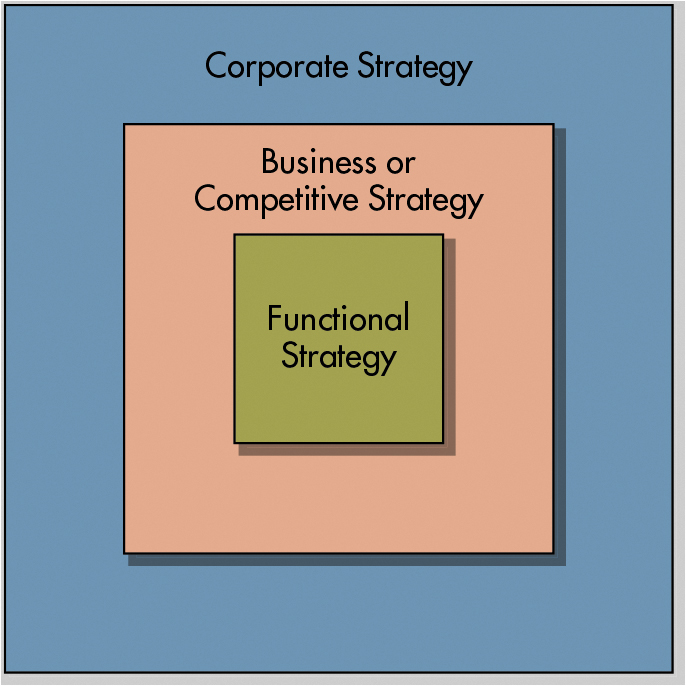
CH.6 BUSINESS ENTERPRISE
~6.1 Management Process~
Management: process of planning, organizing, leading, and controlling an enterprise’s financial, physical, human, and information resources to achieve the organization’s goals
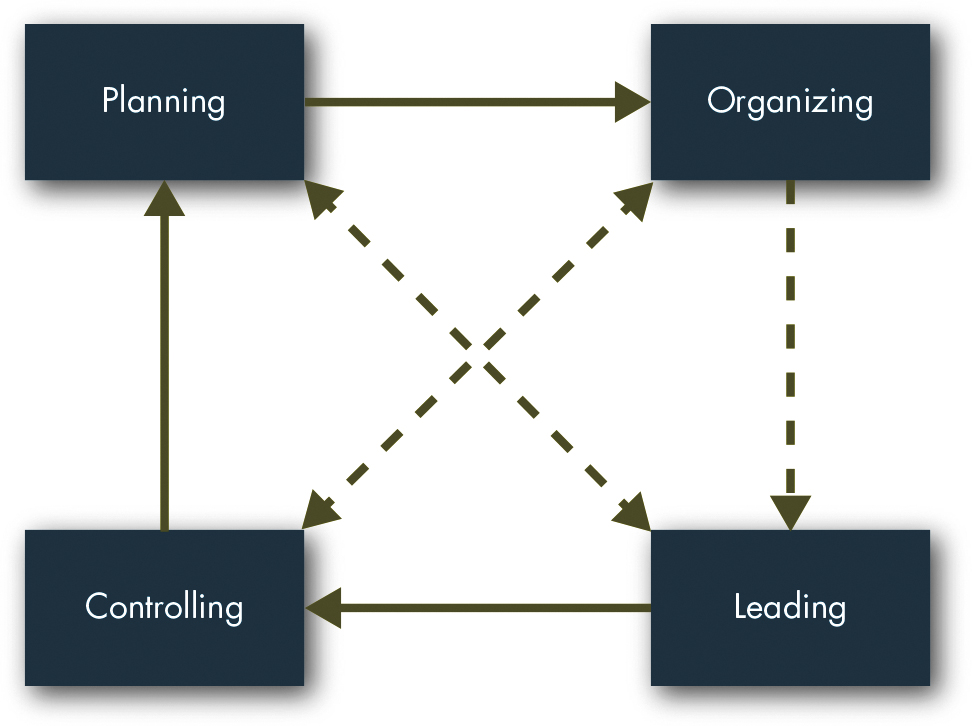
all above aspects are interrelated → manager likely to engage in all these activities in a given business day
difference between management effectiveness & management efficiency
efficiency: achieving greatest level of output with a given input
doing things right
effectiveness: achieving organizational goals that have been set
doing the right things
~Planning~
process of determining the firm’s goals and developing a strategy for achieving those goals
goals are made for the organization
airline sets to goal to fill 90% of its seats
managers identify whether a gap exists between the company’s desired and actual position
airline may analyze data and find that only 73% seats are filled on average
managers develop plans to achieve the desired objectives
airline may reduce fares on heavily travelled routes to increase percentage of seats that are filled
plans that have been decided upon are implemented
the fare from Toronto to Montreal may be reduced by 10%
the effectiveness of the plan is assessed
airline measures the percentage of seats that were filled after the change was implemented to determine whether goal was reached
~Organizing~
mobilizing the necessary resources to complete a particular task
organization charts are often used to help everyone understand roles and reporting relationships
~Leading~
involves interactions between managers and their subordinates as they work to meet company’s objectives
leading goes beyond giving orders
must have ability to motivate employees to set challenging goals and to work hard to achieve them
~Controlling~
process of monitoring a firm’s performance to ensure it’s meeting its goals
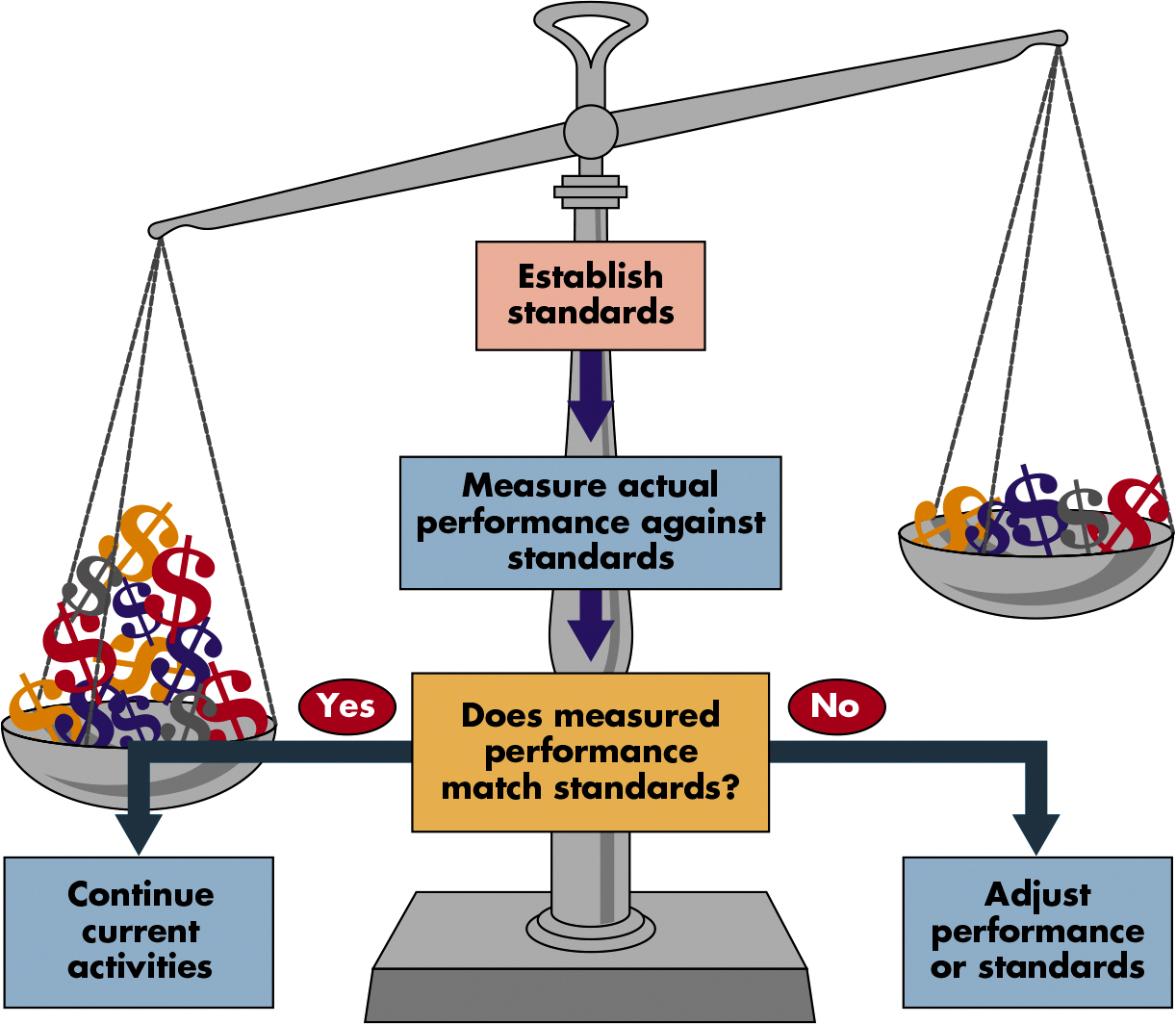
~Five changes for managers to be successful~
“its all about we“ → be concerned about the performance of others
focus on developing skills in communication, influencing, leading team achievement, and developing other people’s abilities
do not give former colleagues and friends special treatment
let subordinates know you trust their work by letting them do it
act with integrity and build trust with others
~6.2 Types of Managers~
managers can be differentiated based on their level/area of responsibility
~levels of management~
Top, middle, and first-line
authority increases as you move up the ~~pyramid
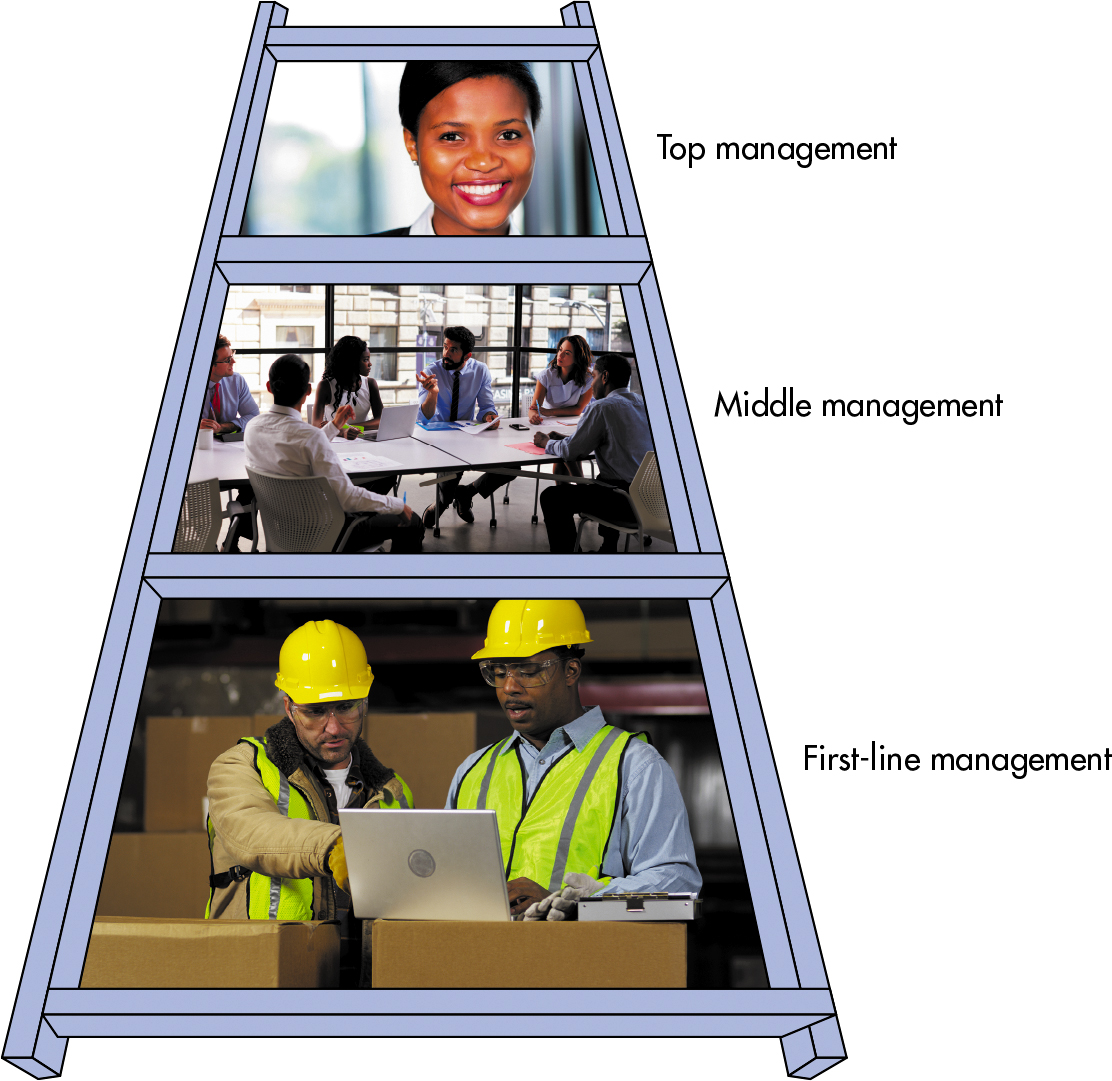
~top managers~
executives that guide fortunes of companies
president, vice president, CEO, etc.
responsible to the board of directors and shareholders of the firm for its overall performance + effectiveness
set general policies, formulate strategies, oversee significant decisions, and represent company in its dealings with other businesses
top managers have an image issue as they’re not very credible
~Middle managers~
responsible for implementing decisions made by top managers
plant manager, operations manager, division manager, etc.
Example: if top management decides to bring out a new product in 12 months or so, MM will have to decide to increase the pace of new product development or to reduce the plant’s workforce
~First-line managers~
responsible for supervising work of employees
supervisor, office manager, group leader, etc.
ensure employees understand and are properly trained in company policies and procedures
~Areas of management~
human resources, operations, information, marketing, and finance
~Human resources~
hire employees, train them, evaluate performance, decide how they should be compensated, and work with labour unions
~Operations managers~
responsible for a company’s system for creating goods + services
responsible for production,, inventory, and quality control
~Information managers~
responsible for designing and implementing various systems to gather, process, and disseminate information
~Marketing managers~
includes development, pricing, promotion, and distribution of products and services
responsible for getting these product + services to buyers
important to firms producing consumer products
~Financial managers~
plans and oversees financial resources
vp for finance → division controller → accounting supervisor
~Other managers~
some firms have more specialized managers
diversity and inclusion officers/ managers have recently been added to many companies
~6.3 management roles/skills~
regardless of level/area within an organization, all managers must play certain roles and possess certain skills if they wanna be successful
~management roles~
what do managers actually do?
Study conducted by Mintzberg found that managers:
work at an unrelenting pace
their activities are characterized by brevity, variety, and fragmentation
prefer live action and emphasized work activities that are current, specific, and well defined
are attracted to verbal media
A manager’s three interpersonal roles
FIGUREHEAD: duties of ceremonial nature, such as attending a subordinate’s wedding
LEADER: being responsible for the work of the unit
LIAISON: making contact outside the vertical chain of command
^these^ give rise to three informational roles
MONITOR: scanning the environment for relevant information
DISSEMINATOR: passing information to subordinates
SPOKESPERSON: sending information to people outside the unit
these interpersonal + informational roles allow manager to carry out four decision-making roles
ENTREPRENEUR: improving the performance of the unit
DISTURBANCE HANDLER: responding to high-pressure disturbances (strike at a supplier)
RESOURCE ALLOCATOR: deciding who will get what in the unit
NEGOTIATOR: working out agreement on a wide variety of issues (amount of authority an individual will be given
~Management skills~
technical, human relations, conceptual, time management, and decision-making skills
~Technical~
allow managers to perform specialized tasks
people develop their technical skills through education and experience
important for first-line managers
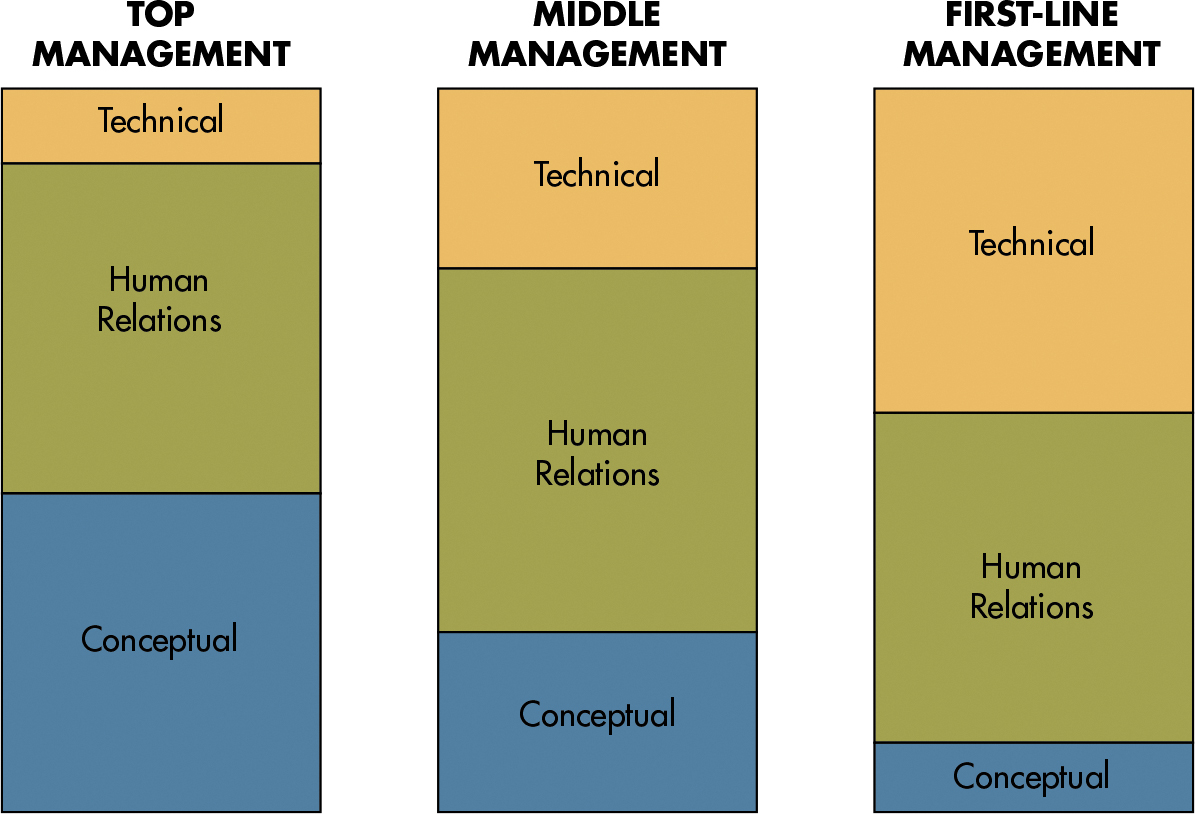
~Human relations~
help managers lead, motivate, communicate with, and get along with their subordinates
managers with poor human relations skills will have conflicts with subordinates, cause valuable employees to quit/transfer, and contribute to poor morale
managers must have good written/verbal communication skills, be critical thinkers (soft skills)
~conceptual skills~
ability to think in the abstract, diagnose, and analyze various situations, and see beyond the present situation
help managers recognize new market opportunities and threats
~Time management skills~
refers to the productive use that managers make of their time
to manage time effectively, managers must address four leading causes of wasted time
**__PAPERWORK: __**some managers spend too much time deciding what to do with letters and reports (digital/paper). Most documents of this sort are routine and can be handled quickly. Managers must learn to recognize those documents that require more attention
THE TELEPHONE: the telephone is estimated to distrub managers every 5 mins. It’s suggested that an executive assistant should be hired to screen all calls and setting some time to return important ones
MEETINGS: keep this time productive, person handling the meeting should specify a clear agenda, start on time, keep everyone focused on the agenda, and end on time
EMAIL/SMS: as the number of these messages increases, so does the potential time wasted
~Decision-Making Skills~
help managers define problems/opportunities and select the best course of action
6 STEPS IN THE RATIONAL DECISION-MAKING PROCESS
recognizing + defining the decision situation
must be stimulus or spark to initiate this process
stimulus for a decision may be wither a problem or opportunity
identifying alternatives
the more important the decision, the more attention is directed to developing alternatives
factors like legal restrictions, moral and ethical norms, and available tech can limit their alternatives
evaluating alternatives
selecting best alternative
implementing chosen alternative
during implementation, employee resistance to change is a key consideration
reasons for resistance may include insecurity, inconvenience, and fear of the unknown
following up and evaluating the results
~behavioural aspects of decision making~
nonlogical and emotional factors often influence managerial decision making
these factors include organizational politics, intuition, escalation of commitment, and risk propensity
~organizational politics~
refers to the actions that people take as they try to get what they want
actions may or may not be beneficial to the organization, but do influence decision making
especially if its being done by a powerful manager
~Intuition~
Managers sometimes do things because they think it “feels right”/ have a “hunch”
is based on years of experience and practice in making decisions in similar situations.
managers should not rely too heavily on intuition in today’s day and age as there is strong data and metrics available
~escalation of commitment~
when a manager stays makes a decision and stays committed to it, even though there’s clear evidence that it may not be good
to avoid this, set specific goals ahead of time
~risk propensity~
how much a manager is willing to gamble when making decisions
be cautious to avoid mistakes
aggressive behaviour during decision making does not work
this could be relying too heavily on intuition, reaching decisions quickly, or risking big amounts of money
~6.4 Strategic Management~
Definition: process of effectively aligning an organization with its external environment
first step: setting goals
goals are mandatory for reaching success
managers must also make decisions about what actions will (not) achieve company goals
decisions cannot be made on a problem-by-problem basis
this is where strategies come in!
Strategies: broad set of organizational plans for implementing the decisions made for achieving organizational goals
~Setting Business Goals~
goals are performance targets
success and failure can be measured by this
indicate what results are desired
whereas plans indicate how these goals are to be achieved
~purpose of goal setting~
provides direction, guidance, and motivation
helps firms allocate resources
helps define corporate culture
helps managers assess performance
~kinds of goals~
goals differ from company to company depending on their vision and mission
vision: why an organization exists and what kind of organization do they wanna be
mission statement: organization’s statement of how it will achieve its purpose in environment in which it conducts its business
mission indicates what they do and purpose indicates why they do it
Long term goals relate to extended periods of time, long into the future
Intermediate goals are set for a period of one to five years into the future
short term goals are set for one year or less
managers who set SMART goals have higher performance than managers who don’t
S: specific
M: measurable
A: achieveable
R: results-oriented
T: time
~Formulating strategy~
after firm has set goals, it must work on making a strategy to achieve them
~Strategy formulation~
Setting strategic goals
are long-term goals that come directly from mission statement
analyzing the organization and its environment
is assessed by using SWOT ANALYSIS
identifying organizational Strengths and Weaknesses
strengths may include surplus cash, dedicated workforce, ample supply of managerial talent, etc.
weakness may include cash shortage, aging factories, or poor public image
identifying environmental Opportunities and Threats
opp: market demand for new products, favourable gov’t legislation, shortages of a raw material
threats: new products developed by competitors, unfavourable gov’t regulations, or changes in consumer taste
matching the organization and its environment
firm should attempt to leverage strengths to capitalize on opportunities and counteract threats
shield its weaknesses
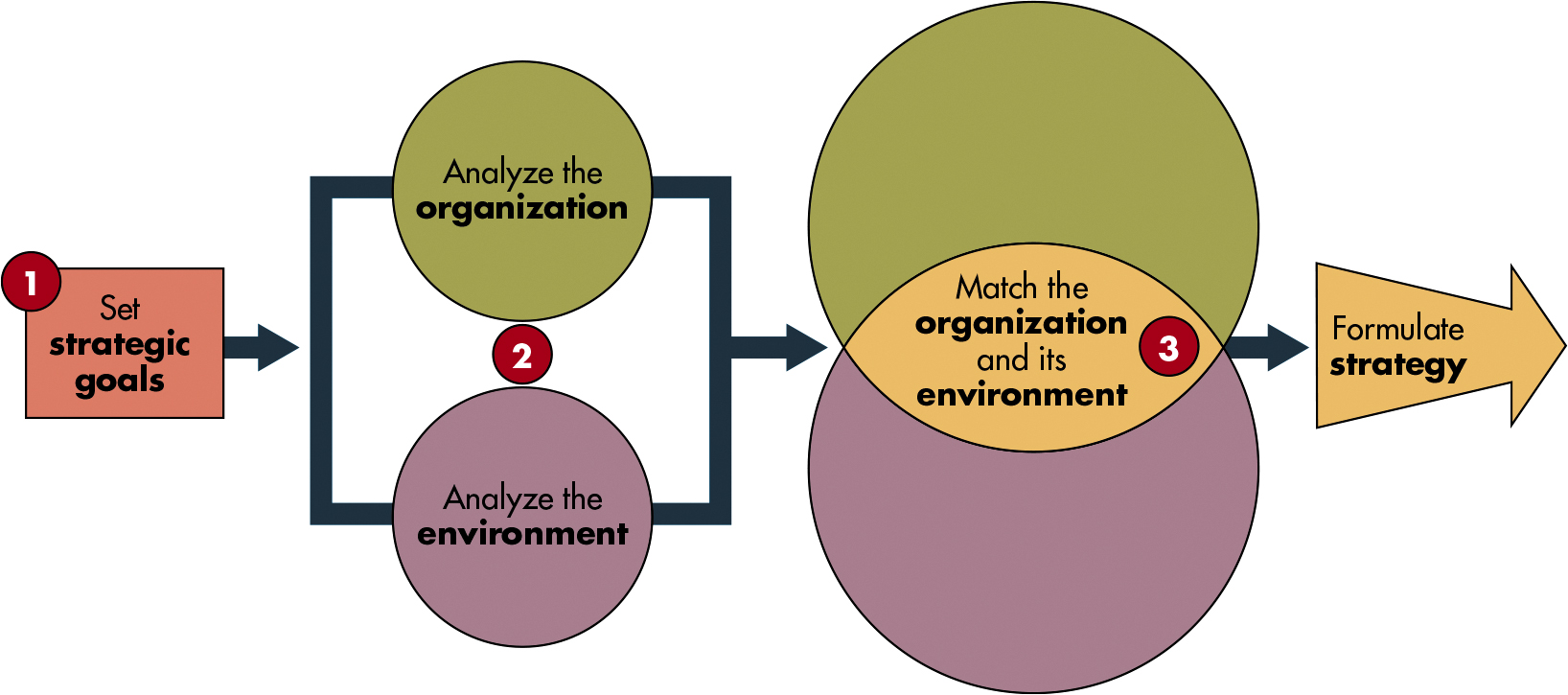 ~hierarchy of plans~
~hierarchy of plans~
Strategic plans: reflect decisions about resource allocations, company priorities, and steps needed to meet strategic goals
usually set by top management
tactical plans: shorter-range ones concerned with implementing specific aspects of the company’s strategic plan
typical involves upper/middle management
operational plans: set short-term targets for daily, weekly, or monthly performance
developed by middle/lower level management
~Levels of strategy~
corporate-level strategy: identifies various businesses a company will be in and how they will relate to each other
concentration
company focuses on one product or product line
growth
market penetration: boosting sales of present products by more aggressive selling in firm’s current market
geographic expansion: expanding operations into new geographic areas
product development: developing improved products for current markets
integration
horizontal integration: acquiring control of competitors in the same or similar markets with the same or similar products
vertical integration: owning or controlling inputs to the firm’s processes or the channels through which the products/services are distributed
diversification: helps avoid the problem of having all its eggs in one basket by spreading risk among several products or markets
related diversification: adding new but related products/services to an existing business
conglomerate diversification: diversifying into products or markets that are not related to the firm’s present business
investment reduction: reducing the company’s investment in one or more of its lines of business
retrenchment: reduction of activity or operations
divestment: selling or liquidating one or more of a firm’s businesses
business-level strategy: identifies the ways a business will compete in its chosen line of products and services
must have a competitive strategy - plan to establish a profitable + sustainable competitive position
Cost leadership: becoming the low-cost leader in the industry
Differentiation: tries to be unique in its industry along some dimension that is valued by buyers
focus strategy: selecting a market segment and serving customers in that market niche better than competitors
functional strategies: identify basic courses of action each department will pursue so that it contributes to the business’s overall goals
each business’ choice of a competitive strategy is translated into supporting functional strategies for each of its departments to pursue
is the basic course of action that each department follow so that the business accomplishes its overall goals
~6.5 Contingency Planning and Crisis Management~
business environments are difficult to predict because unexpected events can occur
Two methods that can deal with the unforeseen are CONTINGENCY PLANNING + CRISIS MANAGEMENT
~Contingency Planning~
definition: identifying in advance changes that might occur and hurt the business + developing a plan to respond to such changes
assessing costs and benefits of options ahead of time helps managers cope with problems when they arise
~Crisis Management~
**__Definition: __**dealing with an emergency that demands an immediate response
can be self-inflicted or imposed by forces outside company’s control
plans outline
who will be in charge in different kinds of circumstances
how organization will respond
plans that exist for assembling and deploying crisis management teams
CH.6 BUSINESS ENTERPRISE
~6.1 Management Process~
Management: process of planning, organizing, leading, and controlling an enterprise’s financial, physical, human, and information resources to achieve the organization’s goals

all above aspects are interrelated → manager likely to engage in all these activities in a given business day
difference between management effectiveness & management efficiency
efficiency: achieving greatest level of output with a given input
doing things right
effectiveness: achieving organizational goals that have been set
doing the right things
~Planning~
process of determining the firm’s goals and developing a strategy for achieving those goals
goals are made for the organization
airline sets to goal to fill 90% of its seats
managers identify whether a gap exists between the company’s desired and actual position
airline may analyze data and find that only 73% seats are filled on average
managers develop plans to achieve the desired objectives
airline may reduce fares on heavily travelled routes to increase percentage of seats that are filled
plans that have been decided upon are implemented
the fare from Toronto to Montreal may be reduced by 10%
the effectiveness of the plan is assessed
airline measures the percentage of seats that were filled after the change was implemented to determine whether goal was reached
~Organizing~
mobilizing the necessary resources to complete a particular task
organization charts are often used to help everyone understand roles and reporting relationships
~Leading~
involves interactions between managers and their subordinates as they work to meet company’s objectives
leading goes beyond giving orders
must have ability to motivate employees to set challenging goals and to work hard to achieve them
~Controlling~
process of monitoring a firm’s performance to ensure it’s meeting its goals

~Five changes for managers to be successful~
“its all about we“ → be concerned about the performance of others
focus on developing skills in communication, influencing, leading team achievement, and developing other people’s abilities
do not give former colleagues and friends special treatment
let subordinates know you trust their work by letting them do it
act with integrity and build trust with others
~6.2 Types of Managers~
managers can be differentiated based on their level/area of responsibility
~levels of management~
Top, middle, and first-line
authority increases as you move up the ~~pyramid

~top managers~
executives that guide fortunes of companies
president, vice president, CEO, etc.
responsible to the board of directors and shareholders of the firm for its overall performance + effectiveness
set general policies, formulate strategies, oversee significant decisions, and represent company in its dealings with other businesses
top managers have an image issue as they’re not very credible
~Middle managers~
responsible for implementing decisions made by top managers
plant manager, operations manager, division manager, etc.
Example: if top management decides to bring out a new product in 12 months or so, MM will have to decide to increase the pace of new product development or to reduce the plant’s workforce
~First-line managers~
responsible for supervising work of employees
supervisor, office manager, group leader, etc.
ensure employees understand and are properly trained in company policies and procedures
~Areas of management~
human resources, operations, information, marketing, and finance
~Human resources~
hire employees, train them, evaluate performance, decide how they should be compensated, and work with labour unions
~Operations managers~
responsible for a company’s system for creating goods + services
responsible for production,, inventory, and quality control
~Information managers~
responsible for designing and implementing various systems to gather, process, and disseminate information
~Marketing managers~
includes development, pricing, promotion, and distribution of products and services
responsible for getting these product + services to buyers
important to firms producing consumer products
~Financial managers~
plans and oversees financial resources
vp for finance → division controller → accounting supervisor
~Other managers~
some firms have more specialized managers
diversity and inclusion officers/ managers have recently been added to many companies
~6.3 management roles/skills~
regardless of level/area within an organization, all managers must play certain roles and possess certain skills if they wanna be successful
~management roles~
what do managers actually do?
Study conducted by Mintzberg found that managers:
work at an unrelenting pace
their activities are characterized by brevity, variety, and fragmentation
prefer live action and emphasized work activities that are current, specific, and well defined
are attracted to verbal media
A manager’s three interpersonal roles
FIGUREHEAD: duties of ceremonial nature, such as attending a subordinate’s wedding
LEADER: being responsible for the work of the unit
LIAISON: making contact outside the vertical chain of command
^these^ give rise to three informational roles
MONITOR: scanning the environment for relevant information
DISSEMINATOR: passing information to subordinates
SPOKESPERSON: sending information to people outside the unit
these interpersonal + informational roles allow manager to carry out four decision-making roles
ENTREPRENEUR: improving the performance of the unit
DISTURBANCE HANDLER: responding to high-pressure disturbances (strike at a supplier)
RESOURCE ALLOCATOR: deciding who will get what in the unit
NEGOTIATOR: working out agreement on a wide variety of issues (amount of authority an individual will be given
~Management skills~
technical, human relations, conceptual, time management, and decision-making skills
~Technical~
allow managers to perform specialized tasks
people develop their technical skills through education and experience
important for first-line managers

~Human relations~
help managers lead, motivate, communicate with, and get along with their subordinates
managers with poor human relations skills will have conflicts with subordinates, cause valuable employees to quit/transfer, and contribute to poor morale
managers must have good written/verbal communication skills, be critical thinkers (soft skills)
~conceptual skills~
ability to think in the abstract, diagnose, and analyze various situations, and see beyond the present situation
help managers recognize new market opportunities and threats
~Time management skills~
refers to the productive use that managers make of their time
to manage time effectively, managers must address four leading causes of wasted time
**__PAPERWORK: __**some managers spend too much time deciding what to do with letters and reports (digital/paper). Most documents of this sort are routine and can be handled quickly. Managers must learn to recognize those documents that require more attention
THE TELEPHONE: the telephone is estimated to distrub managers every 5 mins. It’s suggested that an executive assistant should be hired to screen all calls and setting some time to return important ones
MEETINGS: keep this time productive, person handling the meeting should specify a clear agenda, start on time, keep everyone focused on the agenda, and end on time
EMAIL/SMS: as the number of these messages increases, so does the potential time wasted
~Decision-Making Skills~
help managers define problems/opportunities and select the best course of action
6 STEPS IN THE RATIONAL DECISION-MAKING PROCESS
recognizing + defining the decision situation
must be stimulus or spark to initiate this process
stimulus for a decision may be wither a problem or opportunity
identifying alternatives
the more important the decision, the more attention is directed to developing alternatives
factors like legal restrictions, moral and ethical norms, and available tech can limit their alternatives
evaluating alternatives
selecting best alternative
implementing chosen alternative
during implementation, employee resistance to change is a key consideration
reasons for resistance may include insecurity, inconvenience, and fear of the unknown
following up and evaluating the results
~behavioural aspects of decision making~
nonlogical and emotional factors often influence managerial decision making
these factors include organizational politics, intuition, escalation of commitment, and risk propensity
~organizational politics~
refers to the actions that people take as they try to get what they want
actions may or may not be beneficial to the organization, but do influence decision making
especially if its being done by a powerful manager
~Intuition~
Managers sometimes do things because they think it “feels right”/ have a “hunch”
is based on years of experience and practice in making decisions in similar situations.
managers should not rely too heavily on intuition in today’s day and age as there is strong data and metrics available
~escalation of commitment~
when a manager stays makes a decision and stays committed to it, even though there’s clear evidence that it may not be good
to avoid this, set specific goals ahead of time
~risk propensity~
how much a manager is willing to gamble when making decisions
be cautious to avoid mistakes
aggressive behaviour during decision making does not work
this could be relying too heavily on intuition, reaching decisions quickly, or risking big amounts of money
~6.4 Strategic Management~
Definition: process of effectively aligning an organization with its external environment
first step: setting goals
goals are mandatory for reaching success
managers must also make decisions about what actions will (not) achieve company goals
decisions cannot be made on a problem-by-problem basis
this is where strategies come in!
Strategies: broad set of organizational plans for implementing the decisions made for achieving organizational goals
~Setting Business Goals~
goals are performance targets
success and failure can be measured by this
indicate what results are desired
whereas plans indicate how these goals are to be achieved
~purpose of goal setting~
provides direction, guidance, and motivation
helps firms allocate resources
helps define corporate culture
helps managers assess performance
~kinds of goals~
goals differ from company to company depending on their vision and mission
vision: why an organization exists and what kind of organization do they wanna be
mission statement: organization’s statement of how it will achieve its purpose in environment in which it conducts its business
mission indicates what they do and purpose indicates why they do it
Long term goals relate to extended periods of time, long into the future
Intermediate goals are set for a period of one to five years into the future
short term goals are set for one year or less
managers who set SMART goals have higher performance than managers who don’t
S: specific
M: measurable
A: achieveable
R: results-oriented
T: time
~Formulating strategy~
after firm has set goals, it must work on making a strategy to achieve them
~Strategy formulation~
Setting strategic goals
are long-term goals that come directly from mission statement
analyzing the organization and its environment
is assessed by using SWOT ANALYSIS
identifying organizational Strengths and Weaknesses
strengths may include surplus cash, dedicated workforce, ample supply of managerial talent, etc.
weakness may include cash shortage, aging factories, or poor public image
identifying environmental Opportunities and Threats
opp: market demand for new products, favourable gov’t legislation, shortages of a raw material
threats: new products developed by competitors, unfavourable gov’t regulations, or changes in consumer taste
matching the organization and its environment
firm should attempt to leverage strengths to capitalize on opportunities and counteract threats
shield its weaknesses
 ~hierarchy of plans~
~hierarchy of plans~
Strategic plans: reflect decisions about resource allocations, company priorities, and steps needed to meet strategic goals
usually set by top management
tactical plans: shorter-range ones concerned with implementing specific aspects of the company’s strategic plan
typical involves upper/middle management
operational plans: set short-term targets for daily, weekly, or monthly performance
developed by middle/lower level management
~Levels of strategy~
corporate-level strategy: identifies various businesses a company will be in and how they will relate to each other
concentration
company focuses on one product or product line
growth
market penetration: boosting sales of present products by more aggressive selling in firm’s current market
geographic expansion: expanding operations into new geographic areas
product development: developing improved products for current markets
integration
horizontal integration: acquiring control of competitors in the same or similar markets with the same or similar products
vertical integration: owning or controlling inputs to the firm’s processes or the channels through which the products/services are distributed
diversification: helps avoid the problem of having all its eggs in one basket by spreading risk among several products or markets
related diversification: adding new but related products/services to an existing business
conglomerate diversification: diversifying into products or markets that are not related to the firm’s present business
investment reduction: reducing the company’s investment in one or more of its lines of business
retrenchment: reduction of activity or operations
divestment: selling or liquidating one or more of a firm’s businesses
business-level strategy: identifies the ways a business will compete in its chosen line of products and services
must have a competitive strategy - plan to establish a profitable + sustainable competitive position
Cost leadership: becoming the low-cost leader in the industry
Differentiation: tries to be unique in its industry along some dimension that is valued by buyers
focus strategy: selecting a market segment and serving customers in that market niche better than competitors
functional strategies: identify basic courses of action each department will pursue so that it contributes to the business’s overall goals
each business’ choice of a competitive strategy is translated into supporting functional strategies for each of its departments to pursue
is the basic course of action that each department follow so that the business accomplishes its overall goals
~6.5 Contingency Planning and Crisis Management~
business environments are difficult to predict because unexpected events can occur
Two methods that can deal with the unforeseen are CONTINGENCY PLANNING + CRISIS MANAGEMENT
~Contingency Planning~
definition: identifying in advance changes that might occur and hurt the business + developing a plan to respond to such changes
assessing costs and benefits of options ahead of time helps managers cope with problems when they arise
~Crisis Management~
**__Definition: __**dealing with an emergency that demands an immediate response
can be self-inflicted or imposed by forces outside company’s control
plans outline
who will be in charge in different kinds of circumstances
how organization will respond
plans that exist for assembling and deploying crisis management teams
 Knowt
Knowt